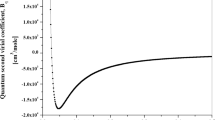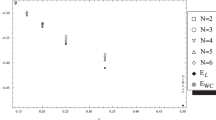Abstract
The Zharkov-Silin Fermi Liquid theory of solutions of4He in normal (non-superfluid) liquid3He is reviewed and slightly extended. The theory is expected to be valid only below ∼0.1 K, and it predicts that there should be a hundred-fold increase in the diffusion coefficient as the temperature is lowered into this region. The limited range of validity explains the apparent disagreement between the recent very low temperature measurements of the phase separation line by Nakamura et al. and extrapolations from higher temperatures. In the low temperature experiments the4He concentration X4 is so small that there is no macroscopic phase separation, only a gradual thickening of the4He-rich film on the walls. We confirm that the phase separation temperature Tps(X4) estimated from the thickening is close to the values which would be observed in an ideal experiment with a macroscopic phase. Fits to Tps(X4) including the new data show that the4He effective mass m *4 is close to, and may be equal to, the bare mass m4. The difference in binding at zero pressure between4He in liquid4He and in liquid3He is (E44−EE43)/kB=(0.21+0.03/−0.01)) K. Using the volume measurements of Laheurte to calculate the pressure dependence of E43 indicates that the difference in binding has a minimum of (0.0±0.2) K near ∼11 atm. This implies that the solubility of4He in3He is enhanced in this region of pressure. The behavior of the spinodal line at low temperature, and the possibility of observing Bose condensation in a metastable solution of4He in liquid3He are also discussed.
Similar content being viewed by others
References
V. N. Zharkov and V. P. Silin,Zh. Eksp. Teor. Fiz. 37, 143 (1960);Soviet Phys. JETP 10, 102 (1960).
W. F. Saam,Phys. Rev. A 4, 1122 (1971).
W. F. Saam and J. P. Laheurte,Phys. Rev. A. 4, 1170 (1971).
R. de Bruyn Ouboter, K. W. Taconis, C. Le Pair and J. J. Beenakker,Physica 26, 853 (1960).
D. O. Edwards and J. G. Daunt,Phys. Rev. 124, 640 (1961).
J. P. Laheurte,J. Low Temp. Phys. 12, 127 (1973).
M. Nakamura, Y. Fujii, T. Shigi, and K. Nagao,J. Phys. Soc. Japan 57, 1676 (1988).
M. Nakamura, G. Shirota, T. Shigematsu, K. Nagao, Y. Fujii, M. Yamaguchi, and T. Shigi,Physica B 165 & 166, 517 (1990).
V. L. Vvedenskii and V. P. Peshkov,Pisma Zh. Eksp. Teor. Fiz. 23, 643 (1976);JETP Lett. 23, 589 (1976).
J. C. Wheatley,Rev. Mod. Phys. 47, 415 (1975).
J. P. Laheurte,Phys. Rev. A 6, 2452 (1972).
L. J. M. Van de Klundert, M. R. E. Bos, J. A. M. Van der Meij, and H. J. Steffens,Phys. Lett. 62A, 487 (1977).
D. O. Edwards, E. M. Ifft, and R. E. Sarwinski,Phys. Rev. 177, 380 (1969).
W. P. Halperin and E. Varoquaux, inHelium Three, W. P. Halperin and L. P. Pitaevskii, eds. (North-Holland, Amsterdam, 1990) p. 353.
H. M. Guo, D. O. Edwards, R. E. Sarwinski and J. T. Tough,Phys. Rev. Lett. 27, 1259 (1971).
C. Ebner and D. O. Edwards,Physics Reports 2C, 77 (1970).
G. Baym and C. Pethick, inThe Physics of Liquid and Solid Helium, Part II, K. H. Bennemann and J. B. Ketterson, eds. (Wiley, New York, 1978) p. 123.
D. O. Edwards and M. S. Pettersen,J. Low Temp. Phys. 87, 473 (1992).
We follow the method used for pure3He in Ref. 20, which has the disadvantage of using a summation over the ill-defined3He quasiparticle states far below the Fermi surface. A method which circumvents this difficulty but which is more complicated was given by Nozieres, Ref. 21.
E. M. Lifshitz and L. P. Pitaevskii,Statistical Physics, Part 2 (Pergamon, Oxford, 1969).
P. Nozieres,Theory of Interacting Fermi Systems (W. A. Benjamin, New York, 1964) Ch. 4.
In this paper we have ignored the “bubble spectrum” ε=ε40+(p−p 0)2/2m *4 wherep 0 is perhaps related to the Fermi momentum. This was suggested by Zharkov and Silin as an alternative to the conventional spectrum in (3.9). It gives a4He contribution to the specific heat of 1/2k B (instead of the 3/2k B from the conventional spectrum) which agrees rather well with the data for a mixture withX 4=4.6% in Ref. [4]. On the other hand the lowest temperature of measurement of the specific heat is 0.4 K, which is probably not low enough for the Fermi Liquid theory to be valid. It is difficult to make results from the bubble spectrum invariant with respect to the choice of the reference liquid and the Galilean transformation.
A. J. Leggett,Ann. Phys. 46, 76 (1968).
See, for example, D. Pines and P. Nozieres'The Theory of Quantum Liquids, Vol. I (W. A. Benjamin, New York, 1966), Ch. 1.
H. J. Maris,Phys. Rev. Lett. 66, 45 (1991).
B. M. Abraham and D. W. Osborne,J. Low Temp. Phys. 5, 335 (1971).
P. R. Bevington,Data Reduction and Error Analysis for the Physical Sciences (McGraw-Hill, New York, 1969).
E. H. Graf, D. M. Lee, and J. D. Reppy,Phys. Rev. Lett. 19, 417 (1967).
R. de Bruyn Ouboter, K. W. Taconis, C. Le Pair, and J. J. M. Beenakker,Physica 26, 853 (1960).
K. N. Zinovieva and V. P. Peshkov,J. Eksp. Teor, Fiz. 37, 33 (1959);Sov. Phys. JETP 37, 22 (1960).
An experiment where a4He coating was used, and the pressure was varied, is described in M. R. Freeman, R. S. Germain, E. V. Thuneberg, and R. C. Richardson,Phys. Rev. Lett. 60, 596 (1988).
Author information
Authors and Affiliations
Rights and permissions
About this article
Cite this article
Edwards, D.O., Pettersen, M.S. & Culman, T.G. The Fermi Liquid theory of4He in3He. J Low Temp Phys 89, 831–857 (1992). https://doi.org/10.1007/BF00683889
Received:
Revised:
Issue Date:
DOI: https://doi.org/10.1007/BF00683889




